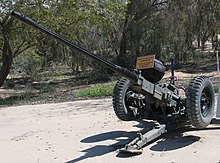| Oerlikon KCB | |
|---|---|
 HS.661 | |
| Type | Autocannon |
| Specifications | |
| Mass | 138 kg |
| Barrel length | 75 caliber |
| Cartridge | 30×170mm |
| Calibre | 30mm |
| Barrels | 1 |
| Action | Gas-operated |
| Rate of fire | 600 round/min |
| Muzzle velocity | 1,080 m/s (3,500 ft/s) |
| Effective firing range | 3,000 m |
The KCB is a 30 mm caliber autocannon, developed by Hispano-Suiza as HS.831.[1] When Oerlikon purchased Hispano's armaments division in 1971, the gun became KCB.[1]
Development[edit]
HS.831 is a scaled-up version of the 20 mm HS.820 and has much the same general operating principles.[1] It uses the 30x170mm round that was developed for this gun.[2] On ground, the HS.820 was used in combination with the HS.661, a single simple anti-aircraft gun mount,[3] and was also mounted on the AMX-13 DCA (Défense Contre Avions), a self-propelled anti-aircraft weapon for the French Army.[4]
In the United Kingdom, BMARC developed A32, a locally operated naval mounting incorporating two HS.831.[1] When the gun was renamed KCB, the A32 became GCM-A series.[1] And LSE (Laurence, Scott & Electricmotors Ltd; presently MSI Defence Systems) also developed a single mount for KCB, which became DS30B.[1] Both GCM-A and DS30B were introduced by the Royal Navy.[1]
The United States Navy designated the twin HS.831 weapons system developed by Emerson Electric as EX-74.[5] This mount was never used by the USN widely, but commercialized as the Emerlec 30 and purchased by foreign navies.[5]
-
HS.661 on display at GADA 601 barracks
-
AMX-13 DCA on display at Musée des Blindés
-
GCM-A on board HMS Battleaxe
-
DS-30B on board HMS Blyth
References[edit]
- ^ a b c d e f g Friedman 1997, pp. 459–460.
- ^ "30mm Rarden". Retrieved November 4, 2022.
- ^ Cullen & Foss 1992, p. 201.
- ^ Cullen & Foss 1992, pp. 63–65.
- ^ a b Friedman 1997, p. 464.
Books[edit]
- Cullen, Tony; Foss, C.F. (1992), Jane's Land-Based Air Defence 1992-93 (5th ed.), Jane's Information Group, ISBN 978-0710609793
- Friedman, Norman (1997), The Naval Institute Guide to World Naval Weapon Systems 1997-1998, Naval Institute Press, ISBN 978-1557502681




Well, that’s interesting to know that Psilotum nudum are known as whisk ferns. Psilotum nudum is the commoner species of the two. While the P. flaccidum is a rare species and is found in the tropical islands. Both the species are usually epiphytic in habit and grow upon tree ferns. These species may also be terrestrial and grow in humus or in the crevices of the rocks.
View the detailed Guide of Psilotum nudum: Detailed Study Of Psilotum Nudum (Whisk Fern), Classification, Anatomy, Reproduction